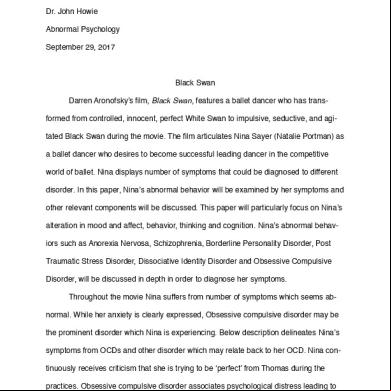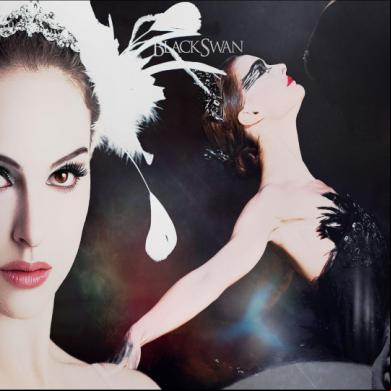Black Swan Pdf 563d5d
This document was ed by and they confirmed that they have the permission to share it. If you are author or own the copyright of this book, please report to us by using this report form. Report 2z6p3t
Overview 5o1f4z
& View Black Swan Pdf as PDF for free.
More details 6z3438
- Words: 1,463
- Pages:
Research Paper
Stanley 1
Amber Stanley Dr. John Howie Abnormal Psychology September 29, 2017
Black Swan Darren Aronofsky’s film, Black Swan, features a ballet dancer who has transformed from controlled, innocent, perfect White Swan to impulsive, seductive, and agitated Black Swan during the movie. The film articulates Nina Sayer (Natalie Portman) as a ballet dancer who desires to become successful leading dancer in the competitive world of ballet. Nina displays number of symptoms that could be diagnosed to different disorder. In this paper, Nina’s abnormal behavior will be examined by her symptoms and other relevant components will be discussed. This paper will particularly focus on Nina’s alteration in mood and affect, behavior, thinking and cognition. Nina’s abnormal behaviors such as Anorexia Nervosa, Schizophrenia, Borderline Personality Disorder, Post Traumatic Stress Disorder, Dissociative Identity Disorder and Obsessive Compulsive Disorder, will be discussed in depth in order to diagnose her symptoms. Throughout the movie Nina suffers from number of symptoms which seems abnormal. While her anxiety is clearly expressed, Obsessive compulsive disorder may be the prominent disorder which Nina is experiencing. Below description delineates Nina’s symptoms from OCDs and other disorder which may relate back to her OCD. Nina continuously receives criticism that she is trying to be ‘perfect’ from Thomas during the practices. Obsessive compulsive disorder associates psychological distress leading to
Research Paper
Stanley 2
anxiety which is a critical marker of this particular disorder. It is defined by unreasonable thoughts and fears along with repetitive behaviors. Dream experiences, affect valence, magical ideation, splitting defense and superego functions may accompany with OCD. (Kai & Yu, 2012). Throughout the film Nina sees hallucinations, experience eating disorder deriving from anxiety, and articulates scratching behavior. From earlier at the movie Nina sees herself ing by in the subway and at the end of the film she perceives herself transforming to a Black Swan. Both of these symptoms suggest that she is suffering from hallucination which may come from her obsessive thoughts. Also Nina’s scratching behavior and self-harming behavior suggest her compulsions. Nina scratched her back until her mother prevented her from damaging her skin by covering her hand with clothes. This scratching behavior reflects her emotional tension and anxiety Nina is experiencing (Vanier & Searight, 2012). It seems that through the competitive occupation influenced Nina to develop such symptoms. Her desire to achieve success and pressure from her mother and Thomas may be the important factor of developing OCD. Throughout the movie, the symptoms of OCD are expressed with very strong visuals in order to convey the dramatic mood. Nina is a white female who lives in an extremely competitive and stressful situation occupation that puts her under pressure to thin and physically light. Research indicates that ballet dancers are at higher risk of developing eating disorder and receive stress from their body image. (Ravaldi, Vannacci, Bolongensi, Stefania, Faravelli & Ricca, 2006). There are number of scene where Nina vomits in the toilet which suggest that she is possibly bulimic. It is unclear if the vomiting happened because of the stressful situation or the reason derives from her attempt to keep her weight light. However the
Research Paper
Stanley 3
cinematography suggests that after she vomit’s, Nina seems to be somewhat relieved from her anxiety. Also her surprisingly thin body shape and her perfectionism suggest possible anorexia nervosa to be diagnosed. Anorexia nervosa consist with symptoms such as refusal to maintain body weight at or above minimally normal level, intense fear of gaining weight, and/or inappropriate evaluation of one’s or shape, or denial of the seriousness of the current low body weight (Durand & Barlow, 2010). The scenes where Nina refuses to eat the cake suggest that she has fear of weight gain. Also her extremely thin body shape suggests that her bodyweight is at minimal level. In the cases of both anorexia and bulimia, article s that these eating disorder are form of OCD. (Neziroglu & Sandler, 2009). Thus Nina’s Eating disorder which may be evaluated as anorexia with following of vomiting behavior may be a spectrum of OCD. The fact that Nina is a white female who lives in competitive occupation hints that her environment may acted as a factor to develop such symptoms. Also pressure of the new position may have also influenced her to develop this disorder. During the film, Nina experiences number of incidence which associates delusions, hallucinations and uncontrolled-disorganized behavior. Schizophrenia is defined by the symptoms that influence individual’s cognitive process and perception. DSM-5 includes symptoms such as delusions, hallucinations, disorganized speech or behavior, and absence of normal mental behaviors (American Psychiatric Association, 2013). Nina’s delusion may be classified as paranoid delusions since her growing suspicion led her to see Thomas having sexual encounter with Lily-which she may have perceived as the reason of Thomas’ favoritism to Lily. The paranoid subtype of schizophrenia may be defined with a person who has preoccupation with one or more delusion or frequent au-
Research Paper
Stanley 4
ditory hallucination but disorganized speech, catatonic behavior or inappropriate affect symptom is not prominent. Although paranoid subtype is not included in DSM-5 anymore, it is important symptoms which suggest Nina is experiencing Schizophrenia because of her obsessive thoughts. While the cinematography never confirms where the delusion begins and ends, it is clear that some of the delusions are developed from Nina’s suspicion toward Lily and the stressful environment. The research found that there is high possibility of OCD and Schizophrenia coexisting (Kruger, Braunig, Hoffer, Shugar, Borner & Julia, 2000). Thus Nina’s paranoid delusions may have come from her obsessive thoughts. Again, her paranoid delusions and hallucinations are articulated in much dramatized tone throughout the movie. Below is a chart of both symptoms retrieved from the OCD newsletter (Neziroglu & Sandler, 2009)
Research Paper
Stanley 5
What I’ve gathered is that, Nina’s fragile mental condition is the result of a gaping disconnect between the external and internal, aspects of her being. Externally, she is enormously talented and accomplished. Internally, she feels empty, unloved, and never sufficiently perfect. This has created a “false self” and she's living in a psychological shell. The hallucinations experienced are visual manifestations of her subconscious and of her ego. The feathers growing from her body exhibit the consumption of her subconscious by the incessant need to perfect the role. The “Devil-Nina” is the embodiment of her insecurities and egotistical fears. Each of the 3 main characters that stand opposite to Nina represent a element of Freudian Psychoanalysis. First, Thomas Leroy, the teacher, he represents the Id, he is the aspect of Nina’s subconscious that yearns for her to let go and to use her sexuality to improve her performance. Second, Erica her Mother, she is the super-ego. She’s moralizing, rigid and the rule following component of Nina’s life. She controls her as if she was still a child and imposes her morality on her. She tries to “protect” her from Lily and Leroy. Third, Lily, she represents Nina’s ego. This is who she wants to be, this is why when she’s hallucinating about killing Lily she actually stabs herself. She envies Lily’s free-spirit and affection that Leroy has for her. Nina’s different symptoms eventually relates back to OCD. Through different research studied, the relationship between OCD and other different disorders draws into a conclusion that Nina is suffering OCD with comorbidity of other disorders.
Research Paper
Stanley 6 References
1. Kai., C., & Yu, C. (2012). Obsessive-compulsive distress and its dynamic associations with schizotypy, borderline personality, and dreaming. Retrieved September 29, 2017, from http://psycnet.apa.org/journals/drm/ 2. Ravaldi, C., Vannacci, A., Bolongensi, E., Stefania, M., Faravelli, C., & Ricca, V. (2006). Gender role, eating disorder symptoms, and body image concern in ballet dancers. Journal of Pyschosomatic research, 61(529-533) 3. Ravaldi, C., Vannacci, A., Bolognesi, E., Mancini, S., Faravelli, C., & Ricca, V. (2006). Gender role, eating disorder symptoms, and body image concern in ballet dancers. Journal of Psychosomatic Research, 61(4), 529-535. 4. Schirmbeck, F., Swets, M., & Haan, L. D. (2015). Epidemiology: Prevalence and Clinical Characteristics of Obsessive-Compulsive Disorder and Obsessive-Compulsive Symptoms in Patients with Psychotic Disorders. Obsessive-Compulsive Symptoms in Schizophrenia, 47-61. 5. Kruger, S., Braunig, P., Hoffer, J., Shugar, G., Borner, I. & Julia, L. (2000, Winter). Prevalence of obsessive-compulsive disorder in schizophrenia and significance of motor symptoms. Retrieved from http://psychiatryonline.org/data/Journals 6. American Psychiatric Association. (2013). Diagnostic and statistical manual of mental th
disorder (5 ed.). Arlington, VA: Amaerican Psychiatric Publishing.
Research Paper
Stanley 7
7. Durand, V., & Barlow, D. (2010). Essential of abnormal psychology. (5th ed.). Belmont, CA: Wadworth. 8. "What is Psychoanalysis" Sigmund Freud Life and Work. (n.d.). Retrieved October 02, 2017, from http://www.freudfile.org/psychoanalysis/definition.html 9. Boeree, C. G. (n.d.). Retrieved October 02, 2017, from http://webspace.ship.edu/cgboer/freud.html 10. Neziroglu, F. & Sandler, J. (2009, Summer). The relationship between eating disorder and OCD: part of spectrum
Stanley 1
Amber Stanley Dr. John Howie Abnormal Psychology September 29, 2017
Black Swan Darren Aronofsky’s film, Black Swan, features a ballet dancer who has transformed from controlled, innocent, perfect White Swan to impulsive, seductive, and agitated Black Swan during the movie. The film articulates Nina Sayer (Natalie Portman) as a ballet dancer who desires to become successful leading dancer in the competitive world of ballet. Nina displays number of symptoms that could be diagnosed to different disorder. In this paper, Nina’s abnormal behavior will be examined by her symptoms and other relevant components will be discussed. This paper will particularly focus on Nina’s alteration in mood and affect, behavior, thinking and cognition. Nina’s abnormal behaviors such as Anorexia Nervosa, Schizophrenia, Borderline Personality Disorder, Post Traumatic Stress Disorder, Dissociative Identity Disorder and Obsessive Compulsive Disorder, will be discussed in depth in order to diagnose her symptoms. Throughout the movie Nina suffers from number of symptoms which seems abnormal. While her anxiety is clearly expressed, Obsessive compulsive disorder may be the prominent disorder which Nina is experiencing. Below description delineates Nina’s symptoms from OCDs and other disorder which may relate back to her OCD. Nina continuously receives criticism that she is trying to be ‘perfect’ from Thomas during the practices. Obsessive compulsive disorder associates psychological distress leading to
Research Paper
Stanley 2
anxiety which is a critical marker of this particular disorder. It is defined by unreasonable thoughts and fears along with repetitive behaviors. Dream experiences, affect valence, magical ideation, splitting defense and superego functions may accompany with OCD. (Kai & Yu, 2012). Throughout the film Nina sees hallucinations, experience eating disorder deriving from anxiety, and articulates scratching behavior. From earlier at the movie Nina sees herself ing by in the subway and at the end of the film she perceives herself transforming to a Black Swan. Both of these symptoms suggest that she is suffering from hallucination which may come from her obsessive thoughts. Also Nina’s scratching behavior and self-harming behavior suggest her compulsions. Nina scratched her back until her mother prevented her from damaging her skin by covering her hand with clothes. This scratching behavior reflects her emotional tension and anxiety Nina is experiencing (Vanier & Searight, 2012). It seems that through the competitive occupation influenced Nina to develop such symptoms. Her desire to achieve success and pressure from her mother and Thomas may be the important factor of developing OCD. Throughout the movie, the symptoms of OCD are expressed with very strong visuals in order to convey the dramatic mood. Nina is a white female who lives in an extremely competitive and stressful situation occupation that puts her under pressure to thin and physically light. Research indicates that ballet dancers are at higher risk of developing eating disorder and receive stress from their body image. (Ravaldi, Vannacci, Bolongensi, Stefania, Faravelli & Ricca, 2006). There are number of scene where Nina vomits in the toilet which suggest that she is possibly bulimic. It is unclear if the vomiting happened because of the stressful situation or the reason derives from her attempt to keep her weight light. However the
Research Paper
Stanley 3
cinematography suggests that after she vomit’s, Nina seems to be somewhat relieved from her anxiety. Also her surprisingly thin body shape and her perfectionism suggest possible anorexia nervosa to be diagnosed. Anorexia nervosa consist with symptoms such as refusal to maintain body weight at or above minimally normal level, intense fear of gaining weight, and/or inappropriate evaluation of one’s or shape, or denial of the seriousness of the current low body weight (Durand & Barlow, 2010). The scenes where Nina refuses to eat the cake suggest that she has fear of weight gain. Also her extremely thin body shape suggests that her bodyweight is at minimal level. In the cases of both anorexia and bulimia, article s that these eating disorder are form of OCD. (Neziroglu & Sandler, 2009). Thus Nina’s Eating disorder which may be evaluated as anorexia with following of vomiting behavior may be a spectrum of OCD. The fact that Nina is a white female who lives in competitive occupation hints that her environment may acted as a factor to develop such symptoms. Also pressure of the new position may have also influenced her to develop this disorder. During the film, Nina experiences number of incidence which associates delusions, hallucinations and uncontrolled-disorganized behavior. Schizophrenia is defined by the symptoms that influence individual’s cognitive process and perception. DSM-5 includes symptoms such as delusions, hallucinations, disorganized speech or behavior, and absence of normal mental behaviors (American Psychiatric Association, 2013). Nina’s delusion may be classified as paranoid delusions since her growing suspicion led her to see Thomas having sexual encounter with Lily-which she may have perceived as the reason of Thomas’ favoritism to Lily. The paranoid subtype of schizophrenia may be defined with a person who has preoccupation with one or more delusion or frequent au-
Research Paper
Stanley 4
ditory hallucination but disorganized speech, catatonic behavior or inappropriate affect symptom is not prominent. Although paranoid subtype is not included in DSM-5 anymore, it is important symptoms which suggest Nina is experiencing Schizophrenia because of her obsessive thoughts. While the cinematography never confirms where the delusion begins and ends, it is clear that some of the delusions are developed from Nina’s suspicion toward Lily and the stressful environment. The research found that there is high possibility of OCD and Schizophrenia coexisting (Kruger, Braunig, Hoffer, Shugar, Borner & Julia, 2000). Thus Nina’s paranoid delusions may have come from her obsessive thoughts. Again, her paranoid delusions and hallucinations are articulated in much dramatized tone throughout the movie. Below is a chart of both symptoms retrieved from the OCD newsletter (Neziroglu & Sandler, 2009)
Research Paper
Stanley 5
What I’ve gathered is that, Nina’s fragile mental condition is the result of a gaping disconnect between the external and internal, aspects of her being. Externally, she is enormously talented and accomplished. Internally, she feels empty, unloved, and never sufficiently perfect. This has created a “false self” and she's living in a psychological shell. The hallucinations experienced are visual manifestations of her subconscious and of her ego. The feathers growing from her body exhibit the consumption of her subconscious by the incessant need to perfect the role. The “Devil-Nina” is the embodiment of her insecurities and egotistical fears. Each of the 3 main characters that stand opposite to Nina represent a element of Freudian Psychoanalysis. First, Thomas Leroy, the teacher, he represents the Id, he is the aspect of Nina’s subconscious that yearns for her to let go and to use her sexuality to improve her performance. Second, Erica her Mother, she is the super-ego. She’s moralizing, rigid and the rule following component of Nina’s life. She controls her as if she was still a child and imposes her morality on her. She tries to “protect” her from Lily and Leroy. Third, Lily, she represents Nina’s ego. This is who she wants to be, this is why when she’s hallucinating about killing Lily she actually stabs herself. She envies Lily’s free-spirit and affection that Leroy has for her. Nina’s different symptoms eventually relates back to OCD. Through different research studied, the relationship between OCD and other different disorders draws into a conclusion that Nina is suffering OCD with comorbidity of other disorders.
Research Paper
Stanley 6 References
1. Kai., C., & Yu, C. (2012). Obsessive-compulsive distress and its dynamic associations with schizotypy, borderline personality, and dreaming. Retrieved September 29, 2017, from http://psycnet.apa.org/journals/drm/ 2. Ravaldi, C., Vannacci, A., Bolongensi, E., Stefania, M., Faravelli, C., & Ricca, V. (2006). Gender role, eating disorder symptoms, and body image concern in ballet dancers. Journal of Pyschosomatic research, 61(529-533) 3. Ravaldi, C., Vannacci, A., Bolognesi, E., Mancini, S., Faravelli, C., & Ricca, V. (2006). Gender role, eating disorder symptoms, and body image concern in ballet dancers. Journal of Psychosomatic Research, 61(4), 529-535. 4. Schirmbeck, F., Swets, M., & Haan, L. D. (2015). Epidemiology: Prevalence and Clinical Characteristics of Obsessive-Compulsive Disorder and Obsessive-Compulsive Symptoms in Patients with Psychotic Disorders. Obsessive-Compulsive Symptoms in Schizophrenia, 47-61. 5. Kruger, S., Braunig, P., Hoffer, J., Shugar, G., Borner, I. & Julia, L. (2000, Winter). Prevalence of obsessive-compulsive disorder in schizophrenia and significance of motor symptoms. Retrieved from http://psychiatryonline.org/data/Journals 6. American Psychiatric Association. (2013). Diagnostic and statistical manual of mental th
disorder (5 ed.). Arlington, VA: Amaerican Psychiatric Publishing.
Research Paper
Stanley 7
7. Durand, V., & Barlow, D. (2010). Essential of abnormal psychology. (5th ed.). Belmont, CA: Wadworth. 8. "What is Psychoanalysis" Sigmund Freud Life and Work. (n.d.). Retrieved October 02, 2017, from http://www.freudfile.org/psychoanalysis/definition.html 9. Boeree, C. G. (n.d.). Retrieved October 02, 2017, from http://webspace.ship.edu/cgboer/freud.html 10. Neziroglu, F. & Sandler, J. (2009, Summer). The relationship between eating disorder and OCD: part of spectrum










